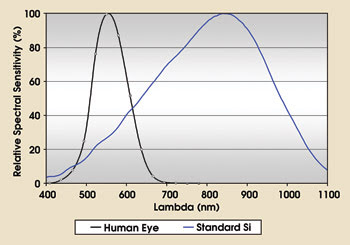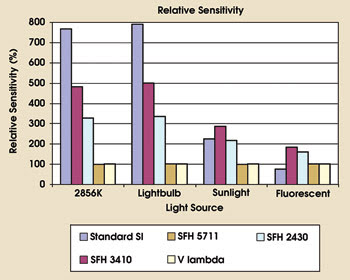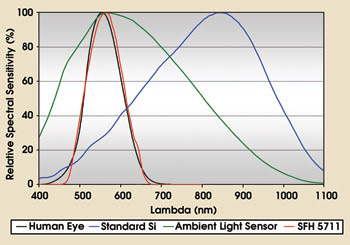The legibility of automotive displays is optimized under changing light conditions.
Sevugan Nagappan, Osram Opto Semiconductors
Brightness and readability in direct sunlight are key factors in the performance, safety and aesthetic appeal of automotive interior displays. These factors determine whether or not a display is used in a particular vehicle application.
Displays are used in many areas in today’s cars, such as instrument clusters, global positioning system screens, audio equipment, entertainment systems and head-up displays. As manufacturers increase the number of displays in a vehicle, the need to manage the brightness in various lighting scenarios will continue to challenge designers.
The majority of automotive lighting applications use liquid crystal displays with cold cathode fluorescent lamp backlighting. Although the brightness can be increased for sunlight readability via the power provided by the DC-AC inverter, the display cannot be dimmed enough for safe and distraction-free driving at night. Hence, the backlight is typically set at a less-than-optimal brightness.
LED lighting
LED backlighting is rapidly replacing cold cathode fluorescent lamp and other display technologies such as vacuum fluorescent and electroluminescent devices. LEDs can provide backlighting with high brightness and superior dimming and, because they are mercury-free, they comply with the European RoHS directive that bans the use of certain hazardous substances in electrical and electronics equipment.
The ideal solution to optimal brightness is automatic dimming of flat panel displays, which maintains the same appearance from darkness to bright sunlight. The same holds true for automatic dimming of instrument panels and illuminated switches. This technology also could extend to headlight control in cars to improve road safety by automatically turning on the lights at twilight or when entering a tunnel.
Several light sensor techniques have been tested to provide an ambient-light sensor in LED-backlit displays. Automatic dimming can be accomplished by silicon-based photosensors such as photocells, photodiodes or phototransistors, but, ideally, such sensing should work as the human eye does. These traditional photodetectors, however, behave differently in that they have different sensitivities for various light sources such as sunlight or incandescent or fluorescent lamps.
Standard silicon photosensors have a spectral response ranging from 350 to 1100 nm, with peak sensitivity around 880 nm. The human eye, however, detects a much narrower wavelength range — from 400 to 700 nm, with peak sensitivity at 560 nm (Figure 1).

Figure 1. The spectral sensitivity of a standard silicon detector is compared with that of the human eye (V-lambda).
Most light sources emit both visible and infrared light. Different light sources can have similar visible brightnesses but different IR emissions. These variations in the emission characteristics and the spectral sensitivity of the detector must be taken into account when measuring brightness.
Standard silicon detectors that detect mostly IR radiation (peak sensitivity at 880 nm) can produce a false reading of ambient visible conditions. For light sources with a high percentage of IR light (incandescent bulbs, for example), the signal received by a standard silicon detector would suggest a much brighter situation than the eye actually sees (Figure 2).

Figure 2. Signals received by a standard silicon detector for different light sources at the same brightness (500 lx) are compared with ambient light sensors (SFH 3410 and SFH2430) and a detector (SFH 5711) with perfect human eye characteristics.
Ambient-light sensors
Ambient-light sensors are photodetectors designed to perceive brightness in the same way the human eye does, and they are proving to be more effective than standard silicon detectors for determining when a display should be adjusted to the ambient-light conditions as perceived by humans.
Most ambient-light sensors also are based on silicon, but they employ different chip structures and filter layers to shift the peak sensitivity and to suppress as much IR radiation as possible (Figure 3). Silicon-based ambient-light sensors have a spectral response from 350 to 1100 nm but with a peak sensitivity around 550 nm, which is nearly identical to the human eye’s maximum sensitivity.

Figure 3. Spectral sensitivity of a standard silicon detector and an ambient-light sensor (SFH 3410) is compared with that of the human eye (V-lambda).
The IR portion of the ambient-light sensor’s spectral sensitivity is less than that of a standard silicon detector, making it less sensitive to the effects of different lamps.
There are various types of ambient-light sensors — phototransistor, photodiode and the latest, which is a hybrid that combines a diode with an integrated circuit.
Phototransistors are small devices with good functionality, whereas photodiodes offer high performance in a larger size. The hybrid offers better spectral sensitivity and dynamic range than the other types. It contains a nonsilicon photodiode to detect light, and its integrated circuit has built-in amplification of the photodiode output signal, logarithmic converter and temperature correction.
The hybrid combines high accuracy over the entire brightness range with low temperature dependence. This type of sensor also has a perfect V-lambda characteristic, which means virtually perfect emulation of human eye sensitivity.
With silicon-based photodetectors, two sensors typically are needed to operate in low light and in very bright ambient conditions, and they can be dimmed only in stages. Also, the photocurrent-luminance correlation achieved by silicon-based photodetectors is linear. In the linear design, the system switches back and forth between various resolutions using different resistances.
With Osram Opto Semiconductors Inc.’s hybrids, such as the SFH 5711 sensor, small changes in light are detectable, allowing adjustment in tiny steps for virtually continuous dimming. The sensor dispenses with the “resistor grid for gain switching” that is used by the linear designs. This not only saves space on the board, but also reduces costs as well.
Meet the author
Sevugan Nagappan is product marketing manager of Infrared & Laser Products at Osram Opto Semiconductors Inc. in Northville, Mich.; e-mail: [email protected].